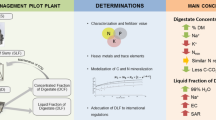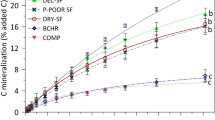Abstract
Solid–liquid separation is now a common slurry management on European farms and many separation techniques are now available. The choice of technique used is based mostly on financial reasons even if the dry matter separation efficiency is also considered. Nevertheless, previous studies showed that the separation technique used influenced the composition of the resulting liquid (LF) and solid (SF) fractions. Hence, our hypothesis is that separation technique influences the C and N dynamics in soils amended with the resulting SF and LF. A laboratory incubation was performed with a sandy soil to assess the influence of five different separation techniques on the N and C dynamics in soil amended with the resulting LF and SF, namely the potential of each fraction for N and organic matter supply to plant and soil systems. Our results showed that the separation technique affects significantly the soil C pools in soils amended with the resulting LF and SF. Nevertheless, the differences between SFs were very low, whereas higher C losses were observed from LFs obtained with active separation techniques such as sieving relative to passive techniques such as sediment settling. The N dynamics in soils amended with the different SF obtained were similar but the extent of NH4 + immobilization differs with the LF considered. Furthermore, higher and faster nitrification was observed with LFs obtained by sediment settling and centrifugation relative to sieving. A higher N mineralization relative to untreated slurry was observed in most fractions and the N mineralization rates were significantly influenced by the separation technique.



Similar content being viewed by others
References
Bechini L, Marino P (2009) Short-term nitrogen fertilizing value of liquid dairy manures is mainly due to ammonium. Soil Sci Soc Am J 73:2159–2169
Bertora C, Alluvione F, Zavattaro L, van Groenigen JW, Velthof G, Grignani C (2008) Pig slurry treatment modifies slurry composition, N2O, and CO2 emissions after soil incorporation. Soil Biol Biochem 40:1999–2006
Chadwick DR, John F, Pain BF, Chambers BJ, Williams J (2000) Plant uptake of nitrogen from the organic nitrogen fraction of animal manures: a laboratory experiment. J Agric Sci 134:159–168
Chantigny MH, Rochette P, Angers DA (2001) Short-term C and N dynamics in a soil amended with pig slurry and barley straw: a field experiment. Can J Soil Sci 81:131–137
Enger H, Riehm H (1958) Die Ammonium laktates sigsäure - Methode zur Bestimmung der leichtlöslichen Phosphorsäure in Karbonathaltigen Böden (In German). Agrochimica III(1):49–65
Fangueiro D, Chadwick D, Dixon L, Bol R (2007) Quantification of priming and CO2 respiration sources following the application of different slurry particle size fractions to a grassland soil. Soil Biol Biochem 39:2608–2620
Fangueiro D, Senbayran M, Trindade H, Chadwick D (2008) Cattle slurry treatment by screw press separation and chemically enhanced settling: effect on greenhouse gas emissions after land spreading and grass yield. Bioresour Technol 99:7132–7142
Fangueiro D, Gusmão M, Grilo J, Porfírio G, Vasconcelos E, Cabral F (2010a) Proportion, composition and potential N mineralisation of particle size fractions obtained by mechanical separation of animal slurry. Biosyst Eng 106:333–337
Fangueiro D, Ribeiro H, Coutinho J, Cardenas L, Trindade H, Cunha-Queda C, Vasconcelos E, Cabral F (2010b) Nitrogen mineralization and CO2 and N2O emissions in a sandy soil amended with original or acidified pig slurries or with the relative fractions. Biol Fertil Soils 46:383–391
Fangueiro D, Lopes C, Surgy S, Vasconcelos E (2012) Effect of the pig slurry separation techniques on the characteristics and potential availability of N to plants in the resulting liquid and solid fractions. Biosyst Eng 113:187–194
Fuente C, Alburquerque JA, Clemente R, Bernal MP (2013) Soil C and N mineralisation and agricultural value of the products of an anaerobic digestion system. Biol Fertil Soils 49:313–322
Griffin TS, He Z, Honeycutt CW (2005) Manure composition affects net transformation of nitrogen from dairy manures. Plant Soil 273:29–38
Grigatti M, Di Girolamo G, Chincarini R, Ciavatta C, Barbanti L (2011) Potential nitrogen mineralization, plant utilization efficiency and soil CO2 emissions following the addition of anaerobic digested slurries. Biomass Bioenergy 35:619–629
Grilo J, Bol R, Dixon L, Chadwick D, Fangueiro D (2011) Long-term release of carbon from grassland soil amended with different slurry particle size fractions: a laboratory incubation study. Rapid Commun Mass Spectrom 25:1514–1520
Guerrero C, Moral R, Gomez I, Zornoza R, Arcenegui V (2007) Microbial biomass and activity of an agricultural soil amended with the solid phase of pig slurries. Bioresour Technol 98:3259–3264
Harding DE, Ross DJ (1964) Some factors in low-temperature storage influencing the mineralisable nitrogen of soils. J Sci Food Agric 15:829–834
Hjorth M, Christensen KV, Christensen ML, Sommer SG (2010) Solid- liquid separation of animal slurry in theory and practice. A review. Agron Sustain Dev 30:153–180
Horneck DA, Miller RO (1998) Determination of total nitrogen in plant tissue. In: Karla P (ed) Handbook of reference methods for plant analysis. CRC, Boca Raton, pp 75–83
Jones A, Panagos P, Barcelo S, Bouraoui F, Bosco C, Dewitte O, Gardi C, Erhard M, Hervás J, Hiederer R, Jeffery S, Lükewille A, Marmo L, Montanarella L, Olazábal C, Petersen J, Penizek V, Strassburger T, Tóth G, Van Den Eeckhaut M, Van Liedekerke M, Verheijen F, Viestova E, Yigini Y (2012) The state of the soil in Europe – a contribution of the JRC to the European Environment Agency's Environment State and Outlook Report-SOER 2010. Publications Office of the European Union, Luxembroug, p 76
Kirchmann H, Lundvall A (1993) Relationship between N immobilization and volatile fatty acids in soil after application of pig and dairy slurry. Biol Fertil Soils 15:161–164
Morvan T, Nicolardot B, Péan L (2006) Biochemical composition and kinetics of C and N mineralization of animal wastes: a typological approach. Biol Fertil Soils 42:513–522
Peters K, Jensen LS (2011) Biochemical characteristics of solid fractions from animal slurry separation and their effects on C and N mineralization in soil. Biol Fertil Soils 47:447–455
Ribeiro H, Fangueiro D, Alves F, Vasconcelos E, Coutinho J, Bol R, Cabral F (2010) Carbon mineralization kinetics in an organically managed cambic arenosol amended with organic fertilizers. J Plant Nutr Soil Sci 173:39–45
Rochette P, Angers DA, Côté D (2000) Soil carbon and nitrogen dynamics following application of pig slurry for the 19th consecutive year: I. Microbial biomass carbon and CO2 fluxes. Soil Sci Soc Am J 64:1389–1395
Rochette P, Angers DA, Chantigny MH, Gagnon B, Bertrand N (2006) In situ mineralization of dairy cattle manures as determined using soil-surface carbon dioxide fluxes. Soil Sci Soc Am J 70:744–752
Sciubba L, Cavani L, Marzadori C, Ciavatta C (2013) Effect of biosolids from municipal sewage sludge composted with rice husk on soil functionality. Biol Fertil Soils 49:597–608
Acknowledgments
The authors gratefully acknowledge funding from Portuguese Fundação para a Ciência e a Tecnologia (FCT) for financially supporting this research through the projects “Animal slurry management: sustainable practices at field scale” (PTDC/AGR-PRO/119428/2010) and (ProjectPEst-OE/AGR/UI0528/2011). David Fangueiro has received a grant from the FCT (SFRH/BPD/84229/2012).
Author information
Authors and Affiliations
Corresponding author
Rights and permissions
About this article
Cite this article
Fangueiro, D., Coutinho, J., Borges, L. et al. Nitrogen and carbon availability of liquid and solid fractions of pig slurry obtained using different separation technologies. Biol Fertil Soils 50, 333–341 (2014). https://doi.org/10.1007/s00374-013-0861-z
Received:
Revised:
Accepted:
Published:
Issue Date:
DOI: https://doi.org/10.1007/s00374-013-0861-z




